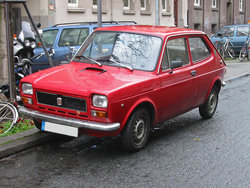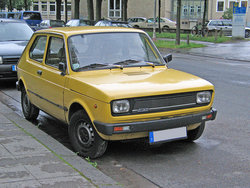Difference between revisions of "Fiat 127"
(No difference)
|
Revision as of 20:57, 24 February 2007
| Fiat 127 | |
|---|---|
| Manufacturer: | Fiat |
| Production: | 1971-1987 |
| Layout & Class: | FF supermini |
| Body Styles: | hatchback sedan |
| Predecessors: | Fiat 850 |
| Successors: | None |

| |
| Series I | |
| Production: | 1971-1977 |

| |
| Series II | |
| Production: | 1977-1987 |
The Fiat 127 was a supermini automobile produced by the Italian manufacturer Fiat between 1971 and 1987.
The 127 was introduced in 1971, and as the replacement for the Fiat 850. Initially only available in two-door sedan form, a three-door hatchback was launched the following year (Fiat's first in the class). The 127 used the tried and trusted 903cc overhead valve engine that had powered many earlier generations of Fiat cars, in conjunction with the state-of-the-art transverse engine and front wheel drive layout which had been pioneered in the Fiat 128, and also featured a unique transverse leaf spring suspension at the rear. The car was one of the first of the modern superminis, and won praise for its utilisation of space (80% of the floor space was available for passengers and luggage) as well as its roadholding. The 127 was an instant success, winning the European Car of the Year award in 1972, and quickly became one of the best-selling cars in Europe for several years.
The Series 2 version of the 127 debuted in 1977. It featured a restyled front and rear, a revised dashboard, larger rear glass area and a new 1049cc engine option. This aluminium headed, overhead cam engine was unique to the 127 range. At the same time a 5-door derivative became available in certain countries. The final revision of the 127 came in 1982 with the Mark 3. Once again the front and end styling was freshened up, and a new 1301cc engine option was introduced. The interior was redesigned and made more modern looking.
However, like all 1970s-vintage Italian cars, the 127 was prone to severe body corrosion, something which was excacerbated by Fiat's use of recycled steel and inadequate undersealing. In warm, dry Mediterranean countries, 127 build quality was acceptable and many examples survive in the present day, but in Northern Europe the combination of damp weather and salty roads had devastating effects on the 127's fragile bodywork. The 127's problems along with similar problems with other Italian cars of the 1970s severely damaged the reputation of Italian automakers in the region, a reputation which they would not fully eliminate until the early 1990s.
Production of the 127 ended in 1987 following the introduction of its replacement, the Fiat Uno.
International variants
As it happened with other Fiat models of that era, SEAT made a Spanish version of this car called the SEAT 127. When their licence from Fiat expired, SEAT redesigned some parts of the car and created the SEAT Fura. Some design parts of this model were also used in the Ibiza Mk. 1.
The 127's underpinnings were also used in certain Fiat-sponsored products such as the Yugo and Yugo Florida from Yugoslavian Zastava company and the Fiat 147 of Brazil.
External links
- FIAT Motor Club (GB)
- Fancy Engineering - UK
- Fiats and turbos
- FIAT Encyclopedia
- Italian used cars
- Tamiya RC car club
- fiat-abarth.net
- theoldcar.com
- Bruce's Parts Bin - Fiat Parts
- Mirafiori.com
- Dino Enterprises - New Zealand
| <- Previous Fiat car timeline, European market, 1960s-1980s Next -> | ||||||||||||||||||||||||||||||||||||||||||||||||||
|---|---|---|---|---|---|---|---|---|---|---|---|---|---|---|---|---|---|---|---|---|---|---|---|---|---|---|---|---|---|---|---|---|---|---|---|---|---|---|---|---|---|---|---|---|---|---|---|---|---|---|
| Type | 1960s | 1970s | 1980s | |||||||||||||||||||||||||||||||||||||||||||||||
| 0 | 1 | 2 | 3 | 4 | 5 | 6 | 7 | 8 | 9 | 0 | 1 | 2 | 3 | 4 | 5 | 6 | 7 | 8 | 9 | 0 | 1 | 2 | 3 | 4 | 5 | 6 | 7 | 8 | 9 | |||||||||||||||||||||
| City car | 500 | 126 | ||||||||||||||||||||||||||||||||||||||||||||||||
| 600 | 133 | Panda | ||||||||||||||||||||||||||||||||||||||||||||||||
| Supermini | 850 | 127 | Uno | |||||||||||||||||||||||||||||||||||||||||||||||
| Small family car | 1100 | 128 | Ritmo | Tipo | ||||||||||||||||||||||||||||||||||||||||||||||
| 1300 | 124 | 131 | Regata | |||||||||||||||||||||||||||||||||||||||||||||||
| Large family car | 1500 | 125 | 132 | Argenta | Croma I | |||||||||||||||||||||||||||||||||||||||||||||
| Executive car | 2300 | 130 | ||||||||||||||||||||||||||||||||||||||||||||||||
| Coupé / Roadster | Dino / 124 Sport Spider | 124 Sport Spider | ||||||||||||||||||||||||||||||||||||||||||||||||
| 124 Coupé | ||||||||||||||||||||||||||||||||||||||||||||||||||
| Sports car | 850 Spider | X1/9 | ||||||||||||||||||||||||||||||||||||||||||||||||
| Panel van | Fiorino I | Fiorino II | ||||||||||||||||||||||||||||||||||||||||||||||||
| Compact MPV | 600 Multipla | |||||||||||||||||||||||||||||||||||||||||||||||||
| Van | 600 T | 850 T | 900 T | |||||||||||||||||||||||||||||||||||||||||||||||
| 1100 BLR / ELR / I / T | 238 | |||||||||||||||||||||||||||||||||||||||||||||||||
| 241 | 242 | |||||||||||||||||||||||||||||||||||||||||||||||||
| Daily* | ||||||||||||||||||||||||||||||||||||||||||||||||||
| Ducato I | ||||||||||||||||||||||||||||||||||||||||||||||||||
| Off-road | Campagnola (1101) | Campagnola (1107) | ||||||||||||||||||||||||||||||||||||||||||||||||
| *Rebadged Iveco model | ||||||||||||||||||||||||||||||||||||||||||||||||||